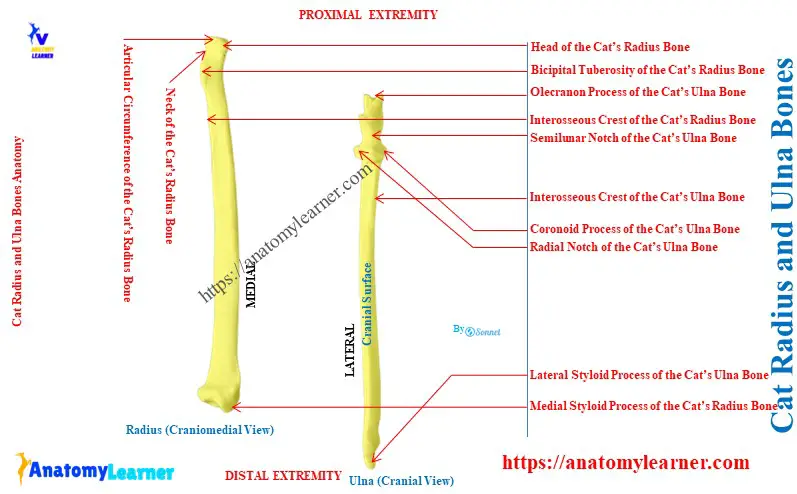The cat radius and ulna are two separate long bones of the forelimb. Here, you will know all the unique osteological features of the cat radius and ulna bones with the diagrams.
Quick answer: both the radius and ulna bones of the cat have a shaft and two extremities. Head, bicipital tuberosity, interosseous crest, and styloid process are the essential osteological features of the cat radius. Again, the olecranon, coronoid process, interosseous crest, and styloid process are the main features of the cat ulnar bone.
I will describe these two long bones separately from the cat’s forelimb with the diagrams. After completing this article, you will also compare the features of the cat’s radius and ulna with other animal’s radius and ulna bones.
Do cats have a radius and ulna?
The cats have a radius and an ulna bone in each forelimb. They are separated bones in cats, and the radius bone crosses over the ulna bones.
Here, the diagram shows the different segments of the forelimb of a cat with a specific bone. The radius and ulna bones from the cat’s forelimb are also identified and shown separately on this diagram.

The proximal and distal extremities are also identified from the cat’s radius and ulna bones. Thus, it might help you to locate the radius and ulna bones from the cat’s forelimb perfectly.
Where is the radius of a cat?
The natural location of the radius on a cat is in the forelimb. They extend from the lateral proximal humeral end to the medial distal carpal extremity.
Thus, this long radius of a cat crosses over the ulna bone. Together, the radius and ulna bones form the forearm segment of the cat’s forelimb.
Here, the diagram shows the extension, location, and relationship between the cat’s radius and ulna bones.
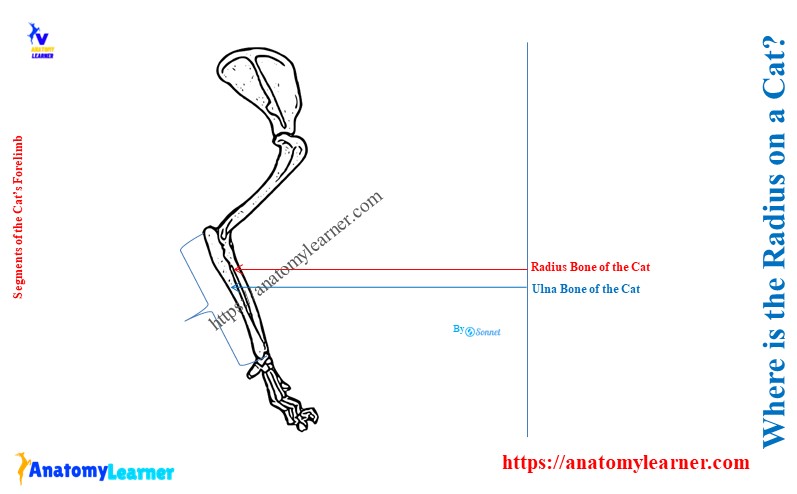
Which side is the radius and ulna?
The radius and ulnar are also separated bones in the cat’s forelimb, like the dog’s. Here, the larger cranial one is the radius of the cat. Again, the smaller, slender, and caudolaterally attached bone is the ulna.
Both the radius and ulna are the long bones in the cat’s skeleton. Here, the radius possesses the typical features of the long bone. But, the ulna of the cat is an developed long bone in its forelimb.
Here, the diagram shows the position of the radius and ulna bones on the cat’s forelimb. Now, you will know the details of the osteological features of the radius and ulna bones separately from the cat’s skeleton.
Cat radius bone anatomy
As a typical long bone, the cat radius bone consists of a body and two extremities. Here, the body is a little curved and flattened craniocaudally. Again, the proximal and distal extremities are little expanded than those of the ox radius bone.
First, let’s try to identify the below-mentioned osteological features from the cat radius bone –
- Smooth convex cranial surface,
- Concave caudal surface,
- Slightly concave medial border,
- More strongly curved lateral surface,
- Interosseous crest of the body of the radius bone,
- Neck and head with articular circumference,
- Bicipital tuberosity,
- Lateral and medial grooves on the craniodental extremity of the radius and
- Styloid process at the distal extremity of the radius,
- Body of the cat radius
The body of the cat radius is different from the body of the ox radius. But, the body represents two surfaces (cranial and caudal) and two borders (lateral and medial).
At the caudolateral surface of the body, there is a bicipital tuberosity. This tuberosity is for the insertion of the tendon of the biceps brachii muscle.
You will also find a rough, elongated bony elevation just distal to the bicipital tuberosity. This rough, elongated bony elevation is the interosseous crest of the body of a cat’s radius bone.
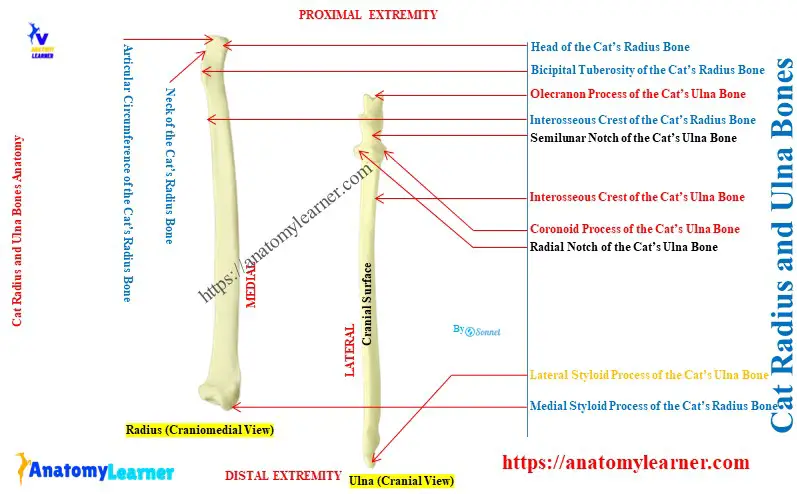
Proximal extremity of the cat radius bone
The osteological features of the proximal extremity of the cat radius are also different from those of the ox radius. Here, the main features of the proximal extremity are the head and neck.
The head of the cat radius is slightly concave and articulates with the capitulum of the humerus. Again, the edge of the head is narrow and possesses a smooth articular circumference. This articular circumference articulates with the notch of the cat’s ulna bone.
The constricted part just below the concave head is the neck. Lateral and medial tuberosities are indistinct in the proximal extremity of the cat’s radius.
Here, the diagram shows the head, articular circumferences, and neck from the proximal part of the cat radius bone.
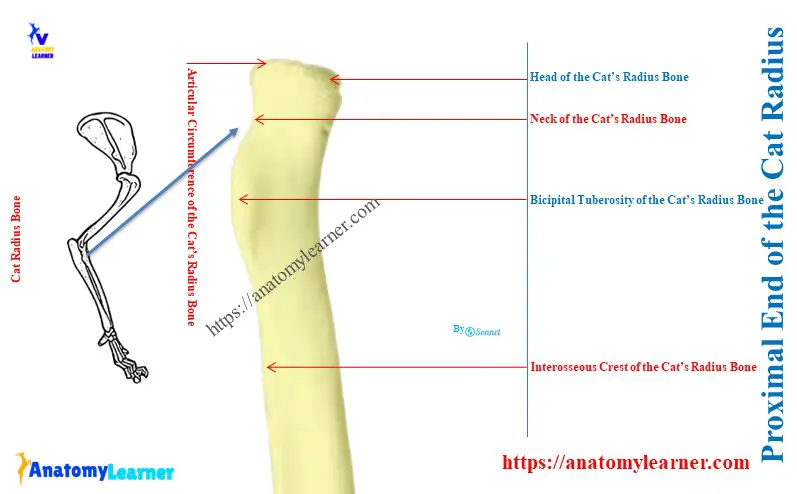
Distal extremity of the cat radius
At the mesiodistal extremity of the cat radius, you will find a styloid process. This is the medial styloid process of the cat radius bone.
Proximal to this styloid process, there is a concave area on the radius bone. With this concave area, the cat’s radius articulates with the scapholunate of the carpals.
On the lateral aspect of the distal extremity, there is a small concave facet. With this small facet, the radius bone articulates with the distal extremity of the ulna bone.
The cranial surface of the distal part of a cat radius represents different grooves. Prominent ridges separate these grooves and allow the passing of the tendons.
Ulna bone of a cat
The ulna is the ill-developed and little twisted long bone of the cat’s forelimb. As a long bone, it also possesses a body and two extremities (proximal and distal).
First, let’s identify the below-mentioned osteological features from the cat’s ulna bone –
- Interosseous crest on the body of the ulna bone,
- Olecranon with semilunar and radial notches,
- Proximal coronoid process, and
- Distal styloid process of the cat ulna bone,
All the osteological features are identified from the cat’s ulna bone in the labelled diagram. Now, you will know the details of every osteological feature from a cat’s ulna with a diagram.
The proximal end of the cat ulna bone
The proximal end of the cat ulan is known as the olecranon. It articulates with the fossa of a cat’s humerus bone.
The tendon of the powerful extensor triceps brachii muscle inserts on the olecranon process of the cat’s ulna. Here, the cranial crescent shape structure of the olecranon process is the semilunar notch.
The trochlea of the cat’s humerus articulates with this semilunar notch of the ulna. There is a large humeral articular surface on the proximal end of the cat’s ulna. Here, you will find two important features – the coronoid process and radial notch.
- Coronoid process: it forms the medial margin of the lateral concave humeral articular surface and
- Radial notch: it is for articulation of the head of the cat’s radius bone.
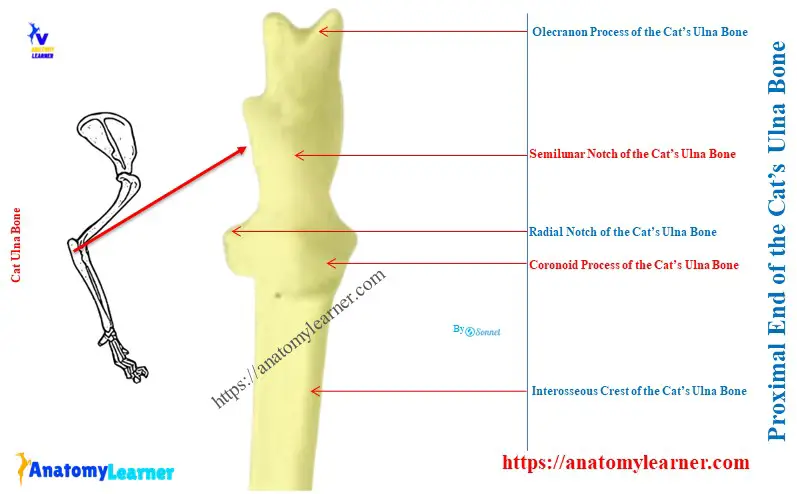
Distal extremity and body of the cat’s ulna bone
The important osteological feature from the distal end of the cat’s ulna is the styloid process. It is a peg-like lateral bony projection of the distal part of the cat’s ulna.
The medial aspect of the distal part possesses facets for the cuneiform and pisiform carpal bones. Again, a small articulating surface may be seen on the medial aspect of the cat’s ulna bone for the radius.
At the cranio-lateral surface of the cat’s ulna, there is a prominent interosseous crest. You will see a tough connective tissue that extends from the interosseous crest radius to the crest of the ulna bones.
Conclusion
So, the radius and ulna are well-decorated long bones of the cat’s forelimb. As the long bone, both possess a shaft and two extremities with different osteological features.

